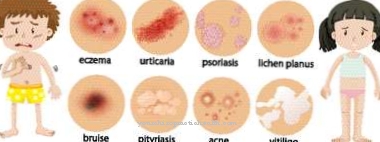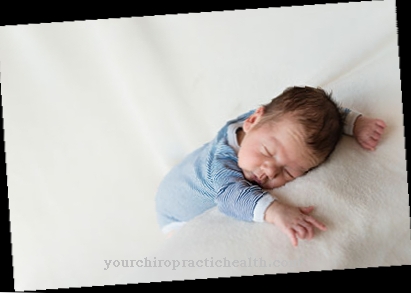As Paget's disease is a disease of the skeleton, also known as Osteodystrophia deformans is known. In Paget's disease, the bone metabolism is disturbed, resulting in thickening of the bones. Paget's disease sufferers are highly susceptible to fractures and deformations.
What is Paget's Disease?

© vecton - stock.adobe.com
Of the Paget's disease is also known as Osteodystrophia deformans and is a disease of the bony musculoskeletal system. Because of an overactive bone metabolism, the bones become thickened over time.
This particularly affects the spine, the pelvic bones and the bones of the lower and upper extremities. Osteodystrophia deformans usually occurs from the age of 40. Since Paget's disease often has no symptoms, it is either not discovered at all or only by chance. B. X-rays are taken due to other complaints.
The bones do not consist of fixed, static structures, but are constantly being remodeled. In particular, two different cell types are involved, the osteoclasts and the osteoblasts. The osteoblasts are used to build up bone substance, the osteoclasts break them down. Normally, the build-up and breakdown are in balance, whereas in Paget's disease this process is uncoordinated.
causes
The causes for one Paget's disease are largely unknown. It is believed that a genetic defect is responsible for the abnormal bone metabolism.
It is currently also being discussed whether an infection with a certain type of virus is a possible trigger, but no reliable results have been presented to date.
Symptoms, ailments & signs
90 percent of all sick people have no symptoms or complaints. In these cases, a diagnosis is usually not made at all. However, ten percent of those affected by Paget's disease have different problems. Cracks and breaks in the bones often lead to severe bone pain.
This can result in misalignments and incorrect loads, which in turn result in pain in the joints and muscles. The pain is often described as diffuse, pulling pain in the affected areas and occurs primarily at night. In the course of the disease, deformations develop in the bones, which are also visible from the outside.
Typical include a shortening of the shin, a curvature of the spine or an enlargement of the head area. Another possible symptom of Paget's disease is overheating of the affected parts of the body. Due to increased blood flow, new blood vessels develop, which can expand and become inflamed due to the high local blood pressure.
The compression of nerve tissue can lead to hearing loss, blindness or pain or even impaired function of the central nervous system. In rare cases, malignant tumors can develop, particularly on the bones in the pelvis, thighs and upper arms. The first signs of this are a significant worsening of the existing symptoms and increasing deformation of the affected bones.
Diagnosis & course
There a Paget's disease does not always show symptoms, it is difficult to diagnose them. Usually it is found incidentally during another examination.
If Paget's disease is suspected, the following tests are carried out. The enzyme alkaline phosphatase (AP) is determined with the help of a blood test, because the AP reveals the activity of the osteoblasts. The osteoclasts are determined using a urine sample. Here the value of the amino acid hydroxyproline is determined.
Furthermore, imaging methods such as B. X-rays, CT scans, and MRIs are used to determine which bones in the skeleton are affected. The areas with increased bone remodeling can be determined particularly well with the help of a bone scintigraphy.
The course of Paget's disease depends on the stage of the disease and how severe it is. Since Paget's disease does not always have symptoms, it may go undetected and the person affected may lead a completely normal life.
In other cases, bone remodeling occurs very quickly, which can result in secondary diseases. Depending on which area is affected, movement restrictions and pain can occur. Thickenings on the spine can squeeze the exiting nerve tracts, so that sensory disorders and paralysis can occur. If the skull is affected in Paget's disease, this can lead to hearing loss and blindness over time. In addition to kidney disease and heart failure, Paget's disease can in rare cases develop into a bone tumor.
Complications
With Paget's disease, patients suffer from severe bone pain. Tension also occurs, which significantly reduces the quality of life of the person affected. In most cases, those affected also suffer from cramps in the muscles and can no longer easily carry out normal activities or sporting activities. Furthermore, the shins of those affected are significantly shortened and the patients suffer from warm extremities.
As the disease progresses, Paget's disease also leads to hearing loss. Especially in children and young people, hearing loss can lead to severe psychological complaints or depression. As a rule, Paget's disease is treated late because it is diagnosed late and only by chance.
This disease also leads to disorders of sensitivity and not infrequently also to paralysis in different areas of the body. Those affected can also go blind. A causal treatment of Paget's disease is usually not possible. Only the symptoms can be limited and reduced in some cases. However, the course of the disease is not completely positive. The life expectancy of the person affected is not influenced or reduced by the disease.
When should you go to the doctor?
Most sufferers do not notice any symptoms of the accompanying bone thickening. Therefore, visits to the doctor are usually avoided. In fact, this bone disease is almost as common as osteoporosis. The onset of the disease is around the age of forty. Most sufferers never see a doctor because of the lack of symptoms.
Treatment is very rarely needed for Paget's disease. Only about ten percent of those affected show Paget's disease through symptoms such as bone pain. The further consequences of this bone disease mostly go unnoticed. However, if symptoms such as an increasing head circumference or so-called saber-sheath shins appear, a doctor should be consulted.
Here there is a risk of joint damage and muscle strain. In addition, new blood vessels form in the affected area. This can lead to overheating. Painful nerve compression or the development of osteosarcomas can occur. The contact person for such complaints is a specialist in internal medicine. Family doctors often fail to realize what is causing the symptoms. In most cases, Paget's disease is discovered by accident during a routine examination or through an MRI scan because of other symptoms.
Treatment & Therapy
There at Paget's disease If the exact cause is not known, only symptomatic treatment can be given. This consists of a drug therapy and physiotherapeutic measures.
Drug therapy includes pain reliever and anti-inflammatory drugs. In addition, Paget's disease is treated with so-called bisphosphonates and the hormone calcitonin.
Bisphosphonates and calcitonin have an inhibitory effect on the osteoclasts, which are responsible for bone resorption. In addition, calcium and vitamin D are administered, which are necessary for healthy bone formation.
In particularly severe cases, surgery may also be necessary. Especially if the hip is damaged, it can be replaced with an artificial joint replacement.
You can find your medication here
➔ Medicines for painOutlook & forecast
The prognosis for Paget's disease is generally different. It depends heavily on the severity of the disease. In around a third of those affected, only a few and limited areas of the bone are affected, so that they do not have any symptoms. On the other hand, less favorable courses (in around two thirds of those affected) are associated with larger affected areas. The slowly progressing course of the disease eventually leads to physical limitations. But even with lesser or more pronounced physical limitations, the life expectancy of Paget's disease is usually not reduced.
In addition, Paget's disease increases the risk of bone cancer. For example, in around one percent of those affected, the bone cells degenerate and so-called Paget's sarcoma or osteosarcoma develops. This requires early treatment and surgical removal. Therefore, those affected by Paget's disease are checked by a doctor at regular intervals. Doctors check the concentration of a certain enzyme in the blood - so-called alkaline phosphatase (AP) - around three months after the start of treatment and then every six months. An increased AP concentration is a possible indicator of a bone tumor or bone metastases.
prevention
Because the cause of a Paget's disease is not known, no preventive measures can be taken. Annual health and preventive checkups should be attended as a general prophylactic measure. In this way, Paget's disease can be detected at an early stage and thus treated appropriately.
You can do that yourself
People who suffer from Paget's disease require medical treatment in any case. This consists of a drug therapy and surgical interventions. The use of medicinal products can be supported by various natural remedies. For example, anti-inflammatory agents such as arnica or belladonna have proven effective. A change in diet ensures that the body receives sufficient vitamin D and calcium, which are essential for healthy bones.
In many cases, Paget's disease requires surgical treatment. After such an operation, the patient must first take it easy. After a few weeks, you can slowly start exercising again, provided the injury has healed sufficiently. If the patient received an artificial joint replacement as part of the operation, physiotherapeutic measures are recommended. In addition to the physician-prescribed physiotherapy, which usually lasts for several weeks to months, the patient can perform movement exercises at home to improve handling of the new joint.
Despite everything, the causal disease continues to cause damage in other parts of the body. That is why the patient has to consult a doctor regularly so that any bone changes can be detected at an early stage. The drug therapy must be regularly adapted to the patient's constitution and the symptoms of the disease.



.jpg)

.jpg)
.jpg)


















.jpg)

.jpg)
